steering wheel KIA Sorento 2007 1.G Owner's Guide
[x] Cancel search | Manufacturer: KIA, Model Year: 2007, Model line: Sorento, Model: KIA Sorento 2007 1.GPages: 325, PDF Size: 5.01 MB
Page 230 of 325

Driving tips22
5If your vehicle slides downhillIf you feel your vehicle starting to slide
sideways, turn downhill immediately. This
should help straighten out the vehicle
and prevent the side slipping. However, a
much better way to prevent this is to get
out and “walk the course” first so you
know what the surface is like before you
drive it.Stalling while crossing an inclineIf your vehicle stalls when you’re crossing
an incline, be sure you (and your pas-
sengers) get out on the uphill side, even
if that door is harder to open. If you get
out on the downhill side and the vehicle
starts to roll over, you’ll be in its path.
If you have to walk down the slope, stay
out of the path the vehicle will take if it
does roll over.
Driving in mud, sand, snow, or iceWhen you drive in mud, sand, snow, or
ice, your wheels won’t get good traction.
You can’t accelerate as quickly, turning is
more difficult, and you’ll need longer
braking distances.
It’s best to use a low gear when you’re in
mud, the deeper the mud, the lower the
gear. In extremely deep mud, the idea is
to keep your vehicle moving so you don’t
get stuck.
When you drive on sand, you’ll sense a
change in wheel traction. But it will
depend upon how loosely packed the
sand is. On loosely packed sand (as on
beaches or sand dunes) your tires will
tend to sink into the sand. This has an
effect on steering, accelerating, and
braking. You may want to reduce the air
pressure in your tires slightly when driv-
ing on sand. This will improve traction.
Remember to re-inflate them the first
chance that you have after you leave the
loosely packed sand.
WARNING
- Exiting vehicle
Getting out on the downhill (low)
side of a vehicle stopped across an
incline is dangerous. If the vehicle
rolls over, you could be crushed or
fatally injured. Always get out on
the uphill (high) side of the vehicle
and stay well clear of the rollover
path.
Page 231 of 325
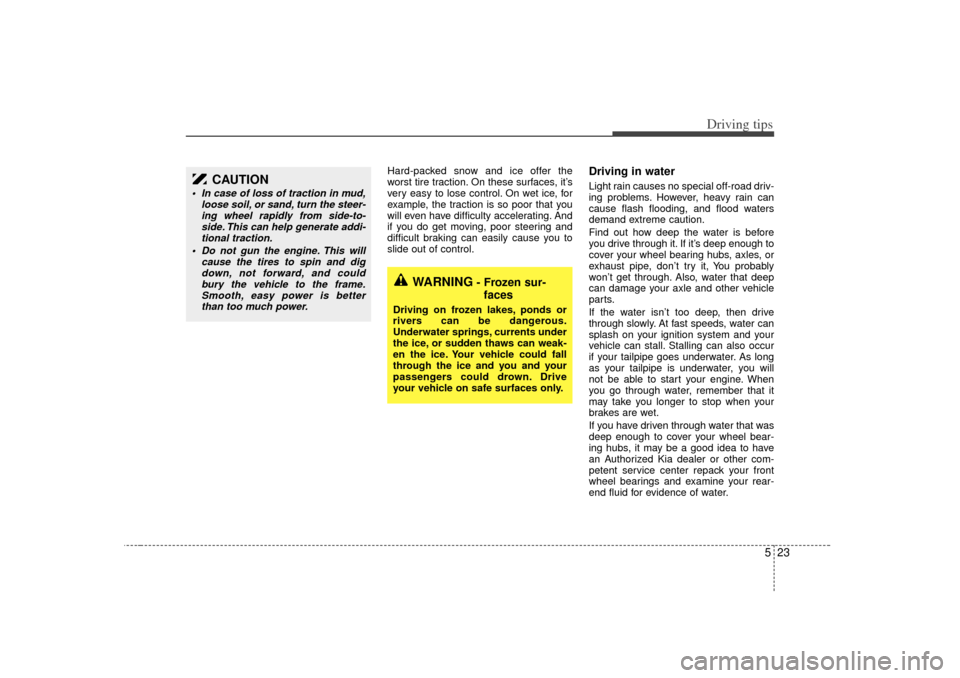
523
Driving tips
Hard-packed snow and ice offer the
worst tire traction. On these surfaces, it’s
very easy to lose control. On wet ice, for
example, the traction is so poor that you
will even have difficulty accelerating. And
if you do get moving, poor steering and
difficult braking can easily cause you to
slide out of control.
Driving in waterLight rain causes no special off-road driv-
ing problems. However, heavy rain can
cause flash flooding, and flood waters
demand extreme caution.
Find out how deep the water is before
you drive through it. If it’s deep enough to
cover your wheel bearing hubs, axles, or
exhaust pipe, don’t try it, You probably
won’t get through. Also, water that deep
can damage your axle and other vehicle
parts.
If the water isn’t too deep, then drive
through slowly. At fast speeds, water can
splash on your ignition system and your
vehicle can stall. Stalling can also occur
if your tailpipe goes underwater. As long
as your tailpipe is underwater, you will
not be able to start your engine. When
you go through water, remember that it
may take you longer to stop when your
brakes are wet.
If you have driven through water that was
deep enough to cover your wheel bear-
ing hubs, it may be a good idea to have
an Authorized Kia dealer or other com-
petent service center repack your front
wheel bearings and examine your rear-
end fluid for evidence of water.
CAUTION
In case of loss of traction in mud,loose soil, or sand, turn the steer-ing wheel rapidly from side-to-side. This can help generate addi- tional traction.
Do not gun the engine. This will cause the tires to spin and digdown, not forward, and couldbury the vehicle to the frame. Smooth, easy power is betterthan too much power.
WARNING
- Frozen sur-
faces
Driving on frozen lakes, ponds or
rivers can be dangerous.
Underwater springs, currents under
the ice, or sudden thaws can weak-
en the ice. Your vehicle could fall
through the ice and you and your
passengers could drown. Drive
your vehicle on safe surfaces only.
Page 232 of 325
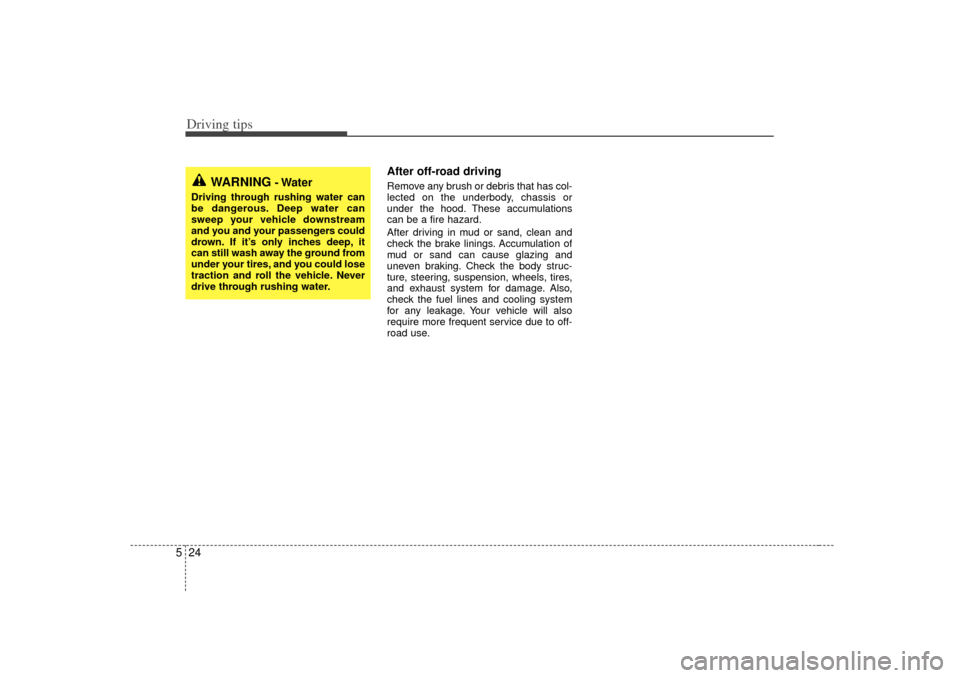
Driving tips24
5
After off-road drivingRemove any brush or debris that has col-
lected on the underbody, chassis or
under the hood. These accumulations
can be a fire hazard.
After driving in mud or sand, clean and
check the brake linings. Accumulation of
mud or sand can cause glazing and
uneven braking. Check the body struc-
ture, steering, suspension, wheels, tires,
and exhaust system for damage. Also,
check the fuel lines and cooling system
for any leakage. Your vehicle will also
require more frequent service due to off-
road use.
WARNING
- Water
Driving through rushing water can
be dangerous. Deep water can
sweep your vehicle downstream
and you and your passengers could
drown. If it’s only inches deep, it
can still wash away the ground from
under your tires, and you could lose
traction and roll the vehicle. Never
drive through rushing water.
Page 243 of 325
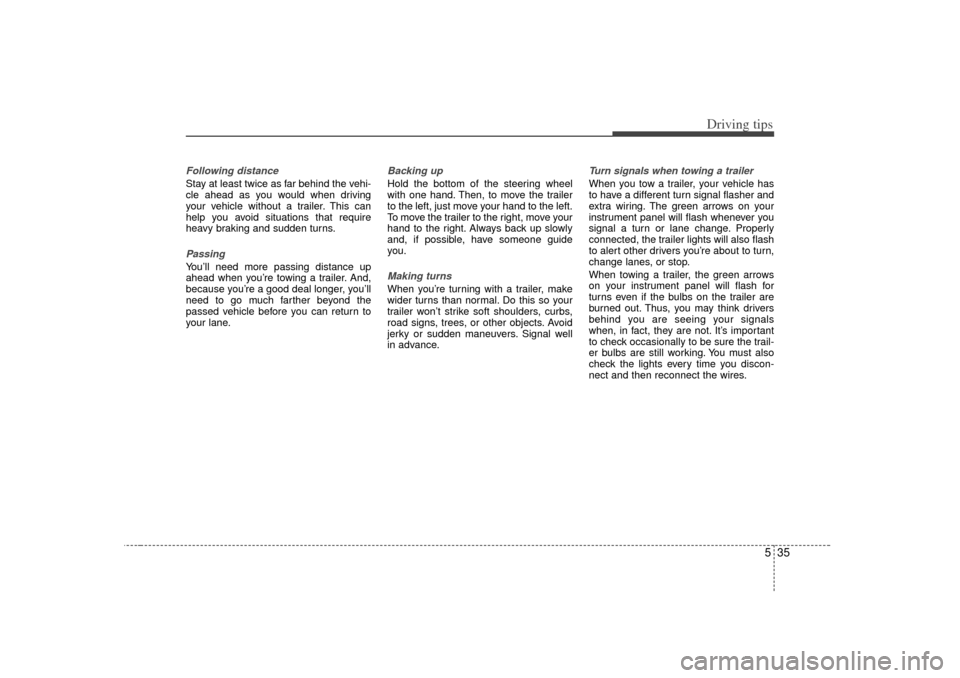
535
Driving tips
Following distance Stay at least twice as far behind the vehi-
cle ahead as you would when driving
your vehicle without a trailer. This can
help you avoid situations that require
heavy braking and sudden turns.Passing Yo u’ll need more passing distance up
ahead when you’ re towing a trailer. And,
because you’ re a good deal longer, you’ll
need to go much farther beyond the
passed vehicle before you can return to
your lane.
Backing up Hold the bottom of the steering wheel
with one hand. Then, to move the trailer
to the left, just move your hand to the left.
To move the trailer to the right, move your
hand to the right. Always back up slowly
and, if possible, have someone guide
you.Making turns When you’ re turning with a trailer, make
wider turns than normal. Do this so your
trailer won’t strike soft shoulders, curbs,
road signs, trees, or other objects. Avoid
jerky or sudden maneuvers. Signal well
in advance.
Turn signals when towing a trailer When you tow a trailer, your vehicle has
to have a different turn signal flasher and
extra wiring. The green arrows on your
instrument panel will flash whenever you
signal a turn or lane change. Properly
connected, the trailer lights will also flash
to alert other drivers you ’re about to turn,
change lanes, or stop.
When towing a trailer, the green arrows
on your instrument panel will flash for
turns even if the bulbs on the trailer are
burned out. Thus, you may think drivers
behind you are seeing your signals
when, in fact, they are not. It ’s important
to check occasionally to be sure the trail-
er bulbs are still working. You must also
check the lights every time you discon-
nect and then reconnect the wires.
Page 264 of 325
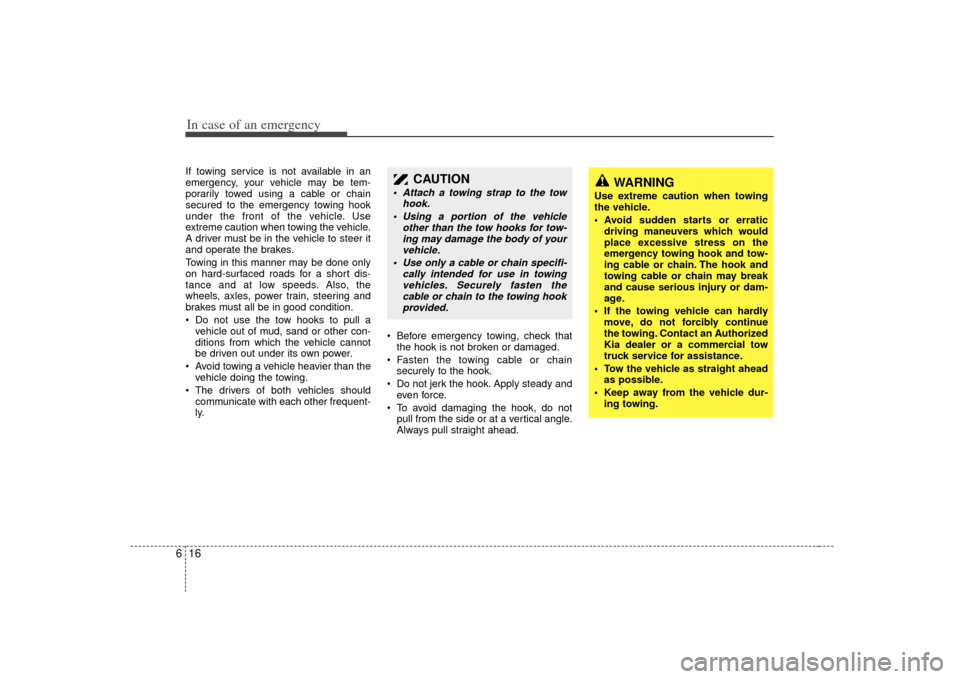
In case of an emergency16
6If towing service is not available in an
emergency, your vehicle may be tem-
porarily towed using a cable or chain
secured to the emergency towing hook
under the front of the vehicle. Use
extreme caution when towing the vehicle.
A driver must be in the vehicle to steer it
and operate the brakes.
Towing in this manner may be done only
on hard-surfaced roads for a short dis-
tance and at low speeds. Also, the
wheels, axles, power train, steering and
brakes must all be in good condition.
Do not use the tow hooks to pull a
vehicle out of mud, sand or other con-
ditions from which the vehicle cannot
be driven out under its own power.
Avoid towing a vehicle heavier than the vehicle doing the towing.
The drivers of both vehicles should communicate with each other frequent-
ly. Before emergency towing, check that
the hook is not broken or damaged.
Fasten the towing cable or chain securely to the hook.
Do not jerk the hook. Apply steady and even force.
To avoid damaging the hook, do not pull from the side or at a vertical angle.
Always pull straight ahead.
CAUTION
Attach a towing strap to the tow hook.
Using a portion of the vehicle other than the tow hooks for tow-ing may damage the body of yourvehicle.
Use only a cable or chain specifi- cally intended for use in towingvehicles. Securely fasten the cable or chain to the towing hookprovided.
WARNING
Use extreme caution when towing
the vehicle.
driving maneuvers which would
place excessive stress on the
emergency towing hook and tow-
ing cable or chain. The hook and
towing cable or chain may break
and cause serious injury or dam-
age.
If the towing vehicle can hardly move, do not forcibly continue
the towing. Contact an Authorized
Kia dealer or a commercial tow
truck service for assistance.
Tow the vehicle as straight ahead as possible.
Keep away from the vehicle dur- ing towing.
Page 265 of 325

617
In case of an emergency
Use a towing strap less than 5 m (16feet) long. Attach a white or red cloth
(about 30 cm (12 inches) wide) in the
middle of the strap for easy visibility.
Drive carefully so that the towing strap is not loosened during towing.
When your vehicle is being towed
by another vehicle other than a tow
truck (in case of an emergency)
(2WD vehicles or part-time 4WD
vehicles) Turn the ignition switch to ACC so thesteering wheel isn’t locked.
Place the transmission shift lever in N (Neutral).
Place the transfer shift knob for part- time 4WD operation in the 2HI posi-
tion.
Release the parking bake.
Vehicle equipped with automatic trans- missions should not exceed 45 km/h
(28 mph) and should not be towed
more than 80 km (50 miles).
✽ ✽ NOTICERemove the rear drive shaft if it is nec-
essary to exceed 45 km/h (28 mph)
and/or 80 km (50 miles). If the drive
shaft cannot be removed, stop every 80
km (50 miles) and start the engine.
Allow the engine to idle for a few min-
utes. This will ensure that the transmis-
sion is sufficiently lubricated.
E4BLA613
Page 274 of 325
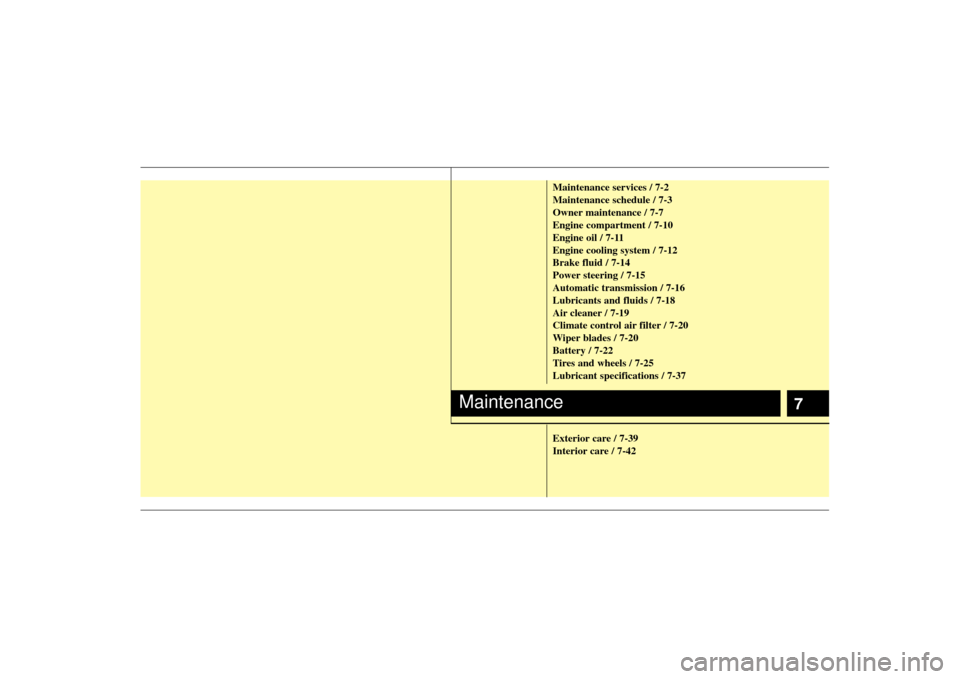
7
Maintenance services / 7-2
Maintenance schedule / 7-3
Owner maintenance / 7-7
Engine compartment / 7-10
Engine oil / 7-11
Engine cooling system / 7-12
Brake fluid / 7-14
Power steering / 7-15
Automatic transmission / 7-16
Lubricants and fluids / 7-18
Air cleaner / 7-19
Climate control air filter / 7-20
Wiper blades / 7-20
Battery / 7-22
Tires and wheels / 7-25
Lubricant specifications / 7-37
Exterior care / 7-39
Interior care / 7-42
Maintenance
Page 278 of 325
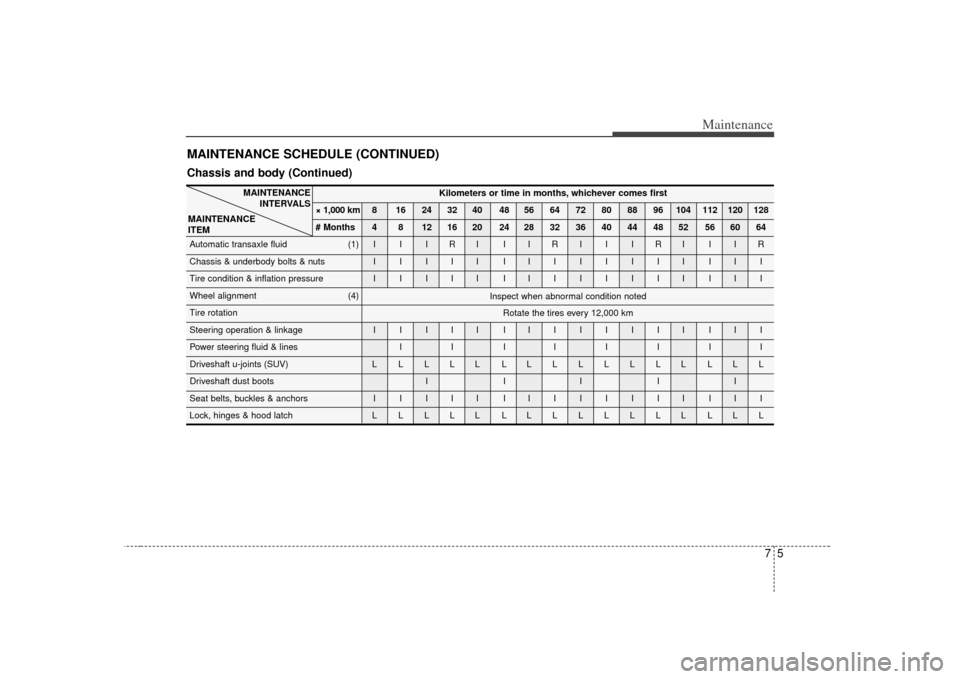
75
Maintenance
MAINTENANCE SCHEDULE (CONTINUED)
MAINTENANCEINTERVALS
MAINTENANCE
ITEM
Inspect when abnormal condition noted
Rotate the tires every 12,000 km
Chassis and body (Continued)
Kilometers or time in months, whichever comes first
× 1,000 km 8 16 24 32 40 48 56 64 72 80 88 96 104 112 120 128
# Months 4 8 12 16 20 24 28 32 36 40 44 48 52 56 60 64
Automatic transaxle fluid (1) I I I R I I I R I I I R I I I R
Chassis & underbody bolts & nuts I I I I I I IIIIIII III
Tire condition & inflation pressure I I I I I I IIIIIII III
Wheel alignment (4)
Tire rotation
Steering operation & linkage I I I I I I IIIIIII III
Power steering fluid & lines I I I IIIII
Driveshaft u-joints (SUV) L L L L L L LLLLLLL LLL
Driveshaft dust boots I I I I I
Seat belts, buckles & anchors I I I I I I IIIIIII III
Lock, hinges & hood latch L L L L L L LLLLLLL LLL
Page 280 of 325
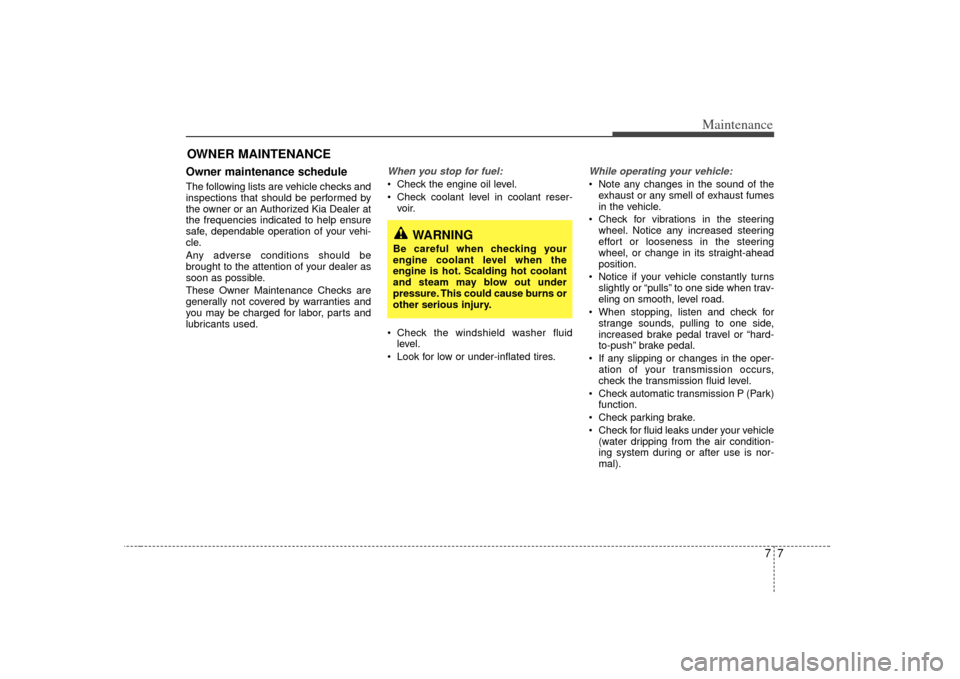
77
Maintenance
OWNER MAINTENANCE Owner maintenance schedule The following lists are vehicle checks and
inspections that should be performed by
the owner or an Authorized Kia Dealer at
the frequencies indicated to help ensure
safe, dependable operation of your vehi-
cle.
Any adverse conditions should be
brought to the attention of your dealer as
soon as possible.
These Owner Maintenance Checks are
generally not covered by warranties and
you may be charged for labor, parts and
lubricants used.
When you stop for fuel: Check the engine oil level.
Check coolant level in coolant reser-voir.
Check the windshield washer fluid level.
Look for low or under-inflated tires.
While operating your vehicle: Note any changes in the sound of the exhaust or any smell of exhaust fumes
in the vehicle.
Check for vibrations in the steering wheel. Notice any increased steering
effort or looseness in the steering
wheel, or change in its straight-ahead
position.
Notice if your vehicle constantly turns slightly or “pulls” to one side when trav-
eling on smooth, level road.
When stopping, listen and check for strange sounds, pulling to one side,
increased brake pedal travel or “hard-
to-push” brake pedal.
If any slipping or changes in the oper- ation of your transmission occurs,
check the transmission fluid level.
Check automatic transmission P (Park) function.
Check parking brake.
Check for fluid leaks under your vehicle (water dripping from the air condition-
ing system during or after use is nor-
mal).
WARNING
Be careful when checking your
engine coolant level when the
engine is hot. Scalding hot coolant
and steam may blow out under
pressure. This could cause burns or
other serious injury.
Page 281 of 325
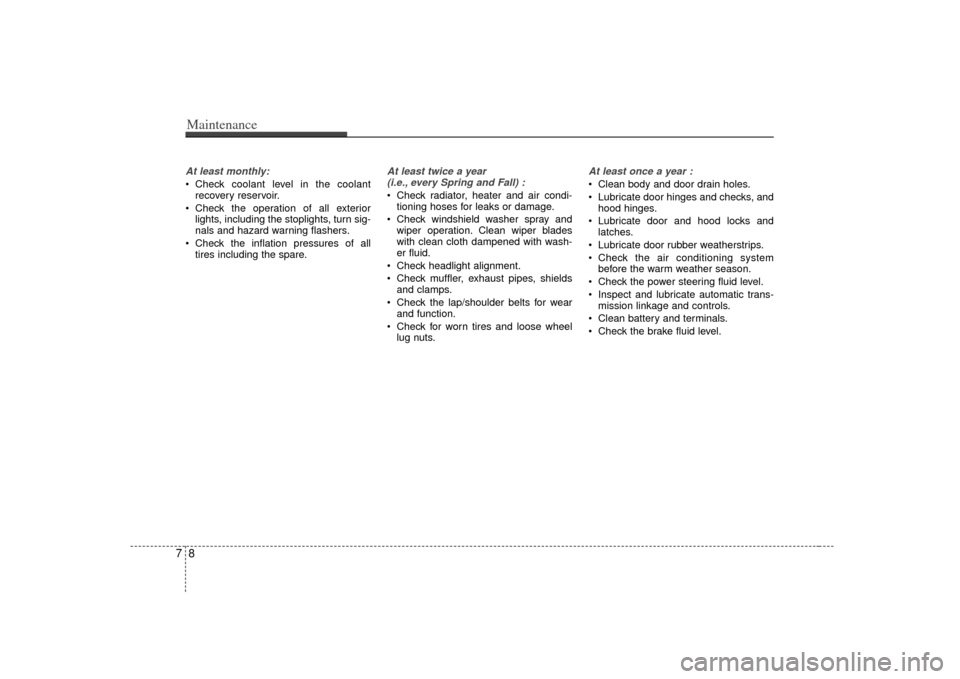
Maintenance87At least monthly: Check coolant level in the coolantrecovery reservoir.
Check the operation of all exterior lights, including the stoplights, turn sig-
nals and hazard warning flashers.
Check the inflation pressures of all tires including the spare.
At least twice a year (i.e., every Spring and Fall) : Check radiator, heater and air condi- tioning hoses for leaks or damage.
Check windshield washer spray and wiper operation. Clean wiper blades
with clean cloth dampened with wash-
er fluid.
Check headlight alignment.
Check muffler, exhaust pipes, shields and clamps.
Check the lap/shoulder belts for wear and function.
Check for worn tires and loose wheel lug nuts.
At least once a year : Clean body and door drain holes.
Lubricate door hinges and checks, andhood hinges.
Lubricate door and hood locks and latches.
Lubricate door rubber weatherstrips.
Check the air conditioning system before the warm weather season.
Check the power steering fluid level.
Inspect and lubricate automatic trans- mission linkage and controls.
Clean battery and terminals.
Check the brake fluid level.